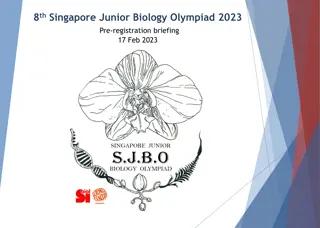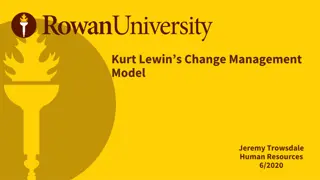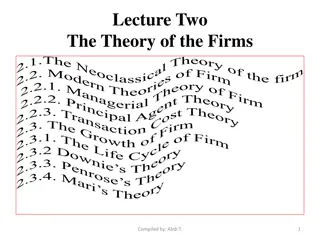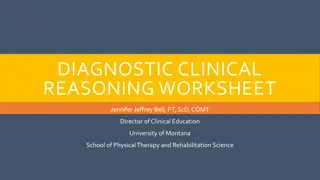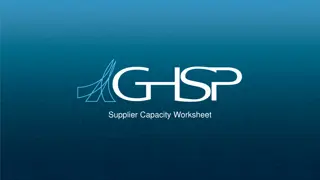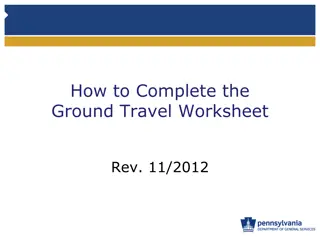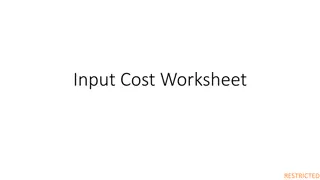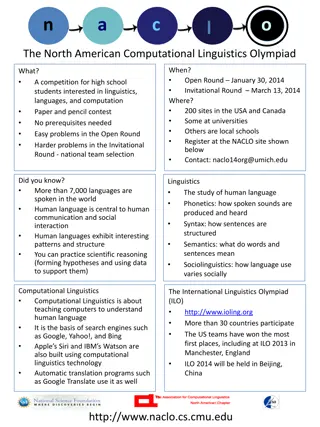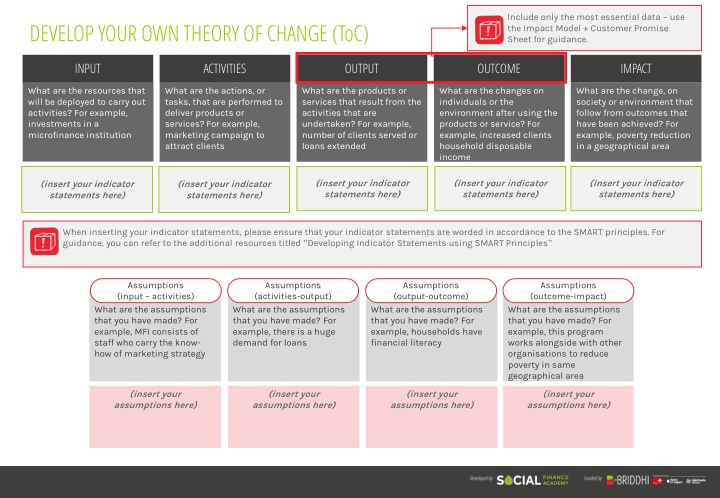
Develop Your Own Theory of Change for Impactful Results
Create a customized Theory of Change using the Impact Model and Customer Promise Sheet, detailing resources, activities, outputs, outcomes, and impact, along with underlying assumptions and key value drivers. Ensure clarity and SMART principles adherence in indicator statements and assumptions.
Download Presentation

Please find below an Image/Link to download the presentation.
The content on the website is provided AS IS for your information and personal use only. It may not be sold, licensed, or shared on other websites without obtaining consent from the author. If you encounter any issues during the download, it is possible that the publisher has removed the file from their server.
You are allowed to download the files provided on this website for personal or commercial use, subject to the condition that they are used lawfully. All files are the property of their respective owners.
The content on the website is provided AS IS for your information and personal use only. It may not be sold, licensed, or shared on other websites without obtaining consent from the author.
E N D
Presentation Transcript
Include only the most essential data use the Impact Model + Customer Promise Sheet for guidance. DEVELOP YOUR OWN THEORY OF CHANGE (ToC) IMPACT INPUT ACTIVITIES OUTPUT OUTCOME What are the resources that will be deployed to carry out activities? For example, investments in a microfinance institution What are the actions, or tasks, that are performed to deliver products or services? For example, marketing campaign to attract clients What are the products or services that result from the activities that are undertaken? For example, number of clients served or loans extended What are the changes on individuals or the environment after using the products or service? For example, increased clients household disposable income What are the change, on society or environment that follow from outcomes that have been achieved? For example, poverty reduction in a geographical area (insert your indicator statements here) (insert your indicator statements here) (insert your indicator statements here) (insert your indicator statements here) (insert your indicator statements here) When inserting your indicator statements, please ensure that your indicator statements are worded in accordance to the SMART principles. For guidance, you can refer to the additional resources titled Developing Indicator Statements using SMART Principles Assumptions (input activities) Assumptions (activities-output) Assumptions (output-outcome) Assumptions (outcome-impact) What are the assumptions that you have made? For example, MFI consists of staff who carry the know- how of marketing strategy What are the assumptions that you have made? For example, there is a huge demand for loans What are the assumptions that you have made? For example, households have financial literacy What are the assumptions that you have made? For example, this program works alongside with other organisations to reduce poverty in same geographical area (insert your assumptions here) (insert your assumptions here) (insert your assumptions here) (insert your assumptions here)
THEORY OF CHANGE TEMPLATE Organize your impact chains (input >activities >output >outcome >impact) into relevant categories. Use the Impact Model + Customer Promise Sheet for guidance Include only the most essential data use the Impact Model + Customer Promise Sheet for guidance. IMPACT INPUT ACTIVITIES OUTPUT OUTCOME (insert your indicator statements here) (insert your indicator statements here) (insert your indicator statements here) (insert your indicator statements here) (insert your indicator statements here) Key Value Driver 1 Assumptions (input activities) Assumptions (activities-output) Assumptions (output-outcome) Assumptions (outcome-impact) (insert your assumptions here) (insert your assumptions here) (insert your assumptions here) (insert your assumptions here) IMPACT INPUT ACTIVITIES OUTPUT OUTCOME (insert your indicator statements here) (insert your indicator statements here) (insert your indicator statements here) (insert your indicator statements here) (insert your indicator statements here) Key Value Driver 1 Assumptions (input activities) Assumptions (activities-output) Assumptions (output-outcome) Assumptions (outcome-impact) (insert your assumptions here) (insert your assumptions here) (insert your assumptions here) (insert your assumptions here)
CUSTOMER PROMISE SHEET MODEL EXAMPLE Page 1 Organize your impact chains (input >activities >output >outcome >impact) into relevant categories. Use the Impact Model + Customer Promise Sheet for guidance Include only the most essential data use the Impact Model + Customer Promise Sheet for guidance. IMPACT INPUT ACTIVITIES OUTPUT OUTCOME Key Value Driver 1: A user-friendly, well-functioning, Web / tech developer Capital Designing app platform 1 user-friendly, well-functioning, and downloadable app developed by the end of Q1 2021 At least 95% of food establishments and consumers provided positive responses in the areas of user- friendliness, functionality, accessibility at the end of 2021 At least 90% complaint cases reported have been resolved at any given time Combat climate change (reduction of GHG emissions) in Dhaka via the use of technology and downloadable app Sustainable food management and consumption in Dhaka Assumptions (input activities) Assumptions (activities-output) Assumptions (output-outcome) Assumptions (outcome-impact) Availability of tech expert and know-how Availability of data (e.g. consumer behavioural patterns or preferences) or software that enable the development of an app that is suitable for local contexts Consumers have mobile phones Food establishments and consumers are willing to share data (there is attractive reward in exchange for data) Staff is well-trained with customer service management Presence of other tech platforms in Dhaka that also focus on food waste reduction IMPACT exchange between consumers and producers INPUT ACTIVITIES OUTPUT OUTCOME Key Value Driver 2: Connectivity and sales Human resources (service management, sales / marketing & communication) Capital Partner collaborations with food establishments Marketing outreach activities Creating incentive structure for riders to delivery food products At least $10,000 sales generated (and 10% commission earned) / yr At least 5,000 of products sold by end of 2021 Expansion of business to 3 new geographical areas by the end of 2022 Expansion of team members by 20% by the end of 2022 Business profit increased by 20% by the end of 2022 Combat climate change (reduction of GHG emissions) in Dhaka via the use of technology Sustainable food management and consumption in Dhaka Assumptions (input activities) Assumptions (activities-output) Assumptions (output-outcome) Assumptions (outcome-impact) Food establishments are willing to participate in the program (e.g. strong incentives via sustainability policies within their organisations) Riders have mobile phones to access the app and incentive structure is attractive enough for riders participation) Recycled food products have sufficient demand Marketing outreach activities are well- targeted (geographically, demographically etc) Riders are fully-committed to the program and there is no significant drop-outs No drastic changes in terms of new competitors Business is able to attract talent to work in the sector in new locations Presence of other tech platforms in Dhaka that also focus on food waste reduction
CUSTOMER PROMISE SHEET MODEL EXAMPLE Page 2 Organize your impact chains (input >activities >output >outcome >impact) into relevant categories. Use the Impact Model + Customer Promise Sheet for guidance Include only the most essential data use the Impact Model + Customer Promise Sheet for guidance. IMPACT INPUT ACTIVITIES OUTPUT OUTCOME Key Value Driver 3: Efficiently and effectively converting food waste into food products Developing recipes for recycled food products Formulate food inventory list with ingredients sourced from various food establishments Repurposing or converting food waste ingredients into new food products Sourcing of packaging materials Total $ value generated from recycled food products developed by end of 2021 At least 85% of food wastes collected have been converted into food products /month Total tonnes of GHG emission reduced by end of 2021 Food waste or products near expiry dates Chef / food creation experts At least 200 types of recycled food products developed by Q1 2021 Sustainable food management and consumption in Dhaka Assumptions (input activities) Assumptions (activities-output) Assumptions (output-outcome) Assumptions (outcome-impact) Availability Sufficient food establishments are committed to the program Food establishments are able to conduct a certain level of quality control on the ingredients that they can provide tech expert and know-how Food ingredients by food establishments are consistently generated and supplied to make recycled food products Food establishment are willing to share food waste data with FoodCycle Presence of other organisations in Dhaka that also focus on food waste reduction Data on GHG emissions in Dhaka accessible in public domain IMPACT INPUT ACTIVITIES OUTPUT OUTCOME Key Value Driver 4: Quality and affordability of food At least 1,500 customers registered on the platform by end of 2021 (and profile of consumers: demographic, geographic, behavioural, needs-based, value based) At least 85% of customers registered purchased at least 1 recycled food product by end of 2021 At least 70% of customers who made purchases returned more than once by end of 2021 At least 95% of customers reported high level of satisfaction on quality and affordability of upcycled food products by end of 2021 At least 85% of customers reported cost saving on household grocery expenses by at least 20% by end of 2021 Household income Browsing through various options of recycled food products via app platform by FoodCycle Access to affordable and nutritional food for low-income populations in Dhaka products Assumptions (input activities) Assumptions (activities-output) Assumptions (output-outcome) Assumptions (outcome-impact) Customers (low-income populations) have access to mobile phones Gender norms (men making decisions on household matters) are not prevalent in Dhaka Customers are willing to share financial information with FoodCycle Presence of reward mechanism to incentivise customers to complete surveys Presence of other organisations in Dhaka that also focus on food waste reduction Data on nutritional health status of low-income population is accessible in public domain

